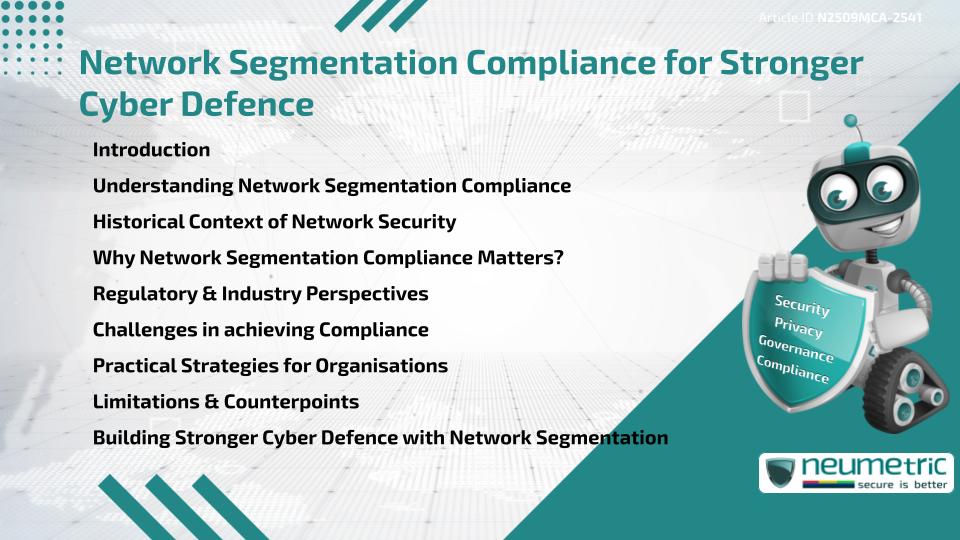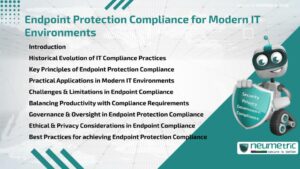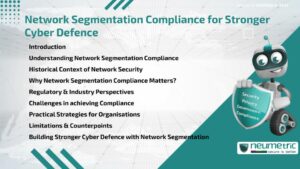Table of Contents
ToggleIntroduction
Network Segmentation Compliance plays a vital role in strengthening Cybersecurity. By dividing networks into smaller, controlled zones, organisations can minimise the Risk of unauthorised access & limit the spread of Potential Threats. Compliance frameworks ensure that segmentation is implemented effectively, aligning with Regulatory Standards & protecting Sensitive Information. With rising Cybersecurity Threats, Network Segmentation Compliance helps organisations secure Critical Assets while meeting Ethical & Regulatory Standards.
Understanding Network Segmentation Compliance
At its core, Network Segmentation Compliance means ensuring that networks are divided logically & securely. Instead of a flat, open network where attackers can move freely, segmentation creates boundaries that restrict access to Confidential Data & Systems & Data. Compliance frameworks provide clear guidance on how segmentation should be designed, maintained & monitored.
For example, separating databases containing Personally Identifiable Information from general Employee networks ensures that even if one area is compromised, Sensitive Data remains protected.
Historical Context of Network Security
Network security has evolved significantly over the decades. In the early days, basic firewalls & perimeter defences were the primary tools. As Cyber Threats became more advanced, intrusion detection systems & layered defences emerged.
Network Segmentation became a recognised practice after large-scale Security Breaches highlighted how attackers could move laterally across unsegmented networks. Compliance frameworks evolved to ensure consistent application of these practices across industries.
Why Network Segmentation Compliance Matters?
Network Segmentation Compliance is crucial for several reasons:
- Risk Reduction: Segmentation reduces the Likelihood of widespread damage by containing Threats.
- Data Protection: Confidential Data such as Patient Records, Financial Information & Customer Information remain isolated & safeguarded.
- Regulatory Standards: Many frameworks, including GDPR Compliance & HIPAA, emphasise segmentation as part of strong Security Controls.
- Customer Trust: Clients & Partners expect organisations to protect Sensitive Customer Information effectively.
Without Compliance, organisations Risk both Financial penalties & Reputational damage.
Regulatory & Industry Perspectives
Regulatory bodies & industry guidelines consistently highlight the importance of segmentation. The Payment Card Industry Data Security Standard [PCI DSS], for example, requires strict separation of payment systems from broader networks. Similarly, ISO 27001 Certification encourages organisations to adopt Controls or Policies that restrict unauthorised access.
Industry Best Practices now recognise segmentation as a foundation of strong Cybersecurity Strategies, particularly in sectors like Finance, Healthcare & Cloud Security.
Challenges in achieving Compliance
Despite its benefits, achieving Network Segmentation Compliance presents challenges:
- Complex Environments: Large organisations with diverse Systems, Processes & Services may struggle to segment effectively.
- Legacy Infrastructure: Outdated hardware or software may not support advanced segmentation.
- Cost: Implementing segmentation requires investment in new tools & training.
- Monitoring: Ensuring continuous effectiveness demands Security Monitoring & regular Audits.
These challenges highlight the importance of planning & phased adoption.
Practical Strategies for Organisations
Organisations can adopt several strategies to improve Compliance:
- Conduct Risk Assessments to identify Critical Assets requiring isolation.
- Use Access Controls to enforce strict boundaries.
- Apply Continuous Monitoring & Improvement to track segmentation effectiveness.
- Train Employees with targeted Security Training Programs.
- Collaborate with Certification Bodies for guidance on Industry Standards.
Taking a layered approach ensures resilience without disrupting Business Operations.
Limitations & Counterpoints
Some argue that segmentation can create unnecessary complexity if not managed well. Misconfigured segmentation may block legitimate communication between systems, leading to operational inefficiencies. Others note that segmentation alone is not a silver bullet-it must be combined with other Security Measures like Endpoint Protection & Threat Intelligence.
Nonetheless, history shows that organisations with effective segmentation withstand attacks far better than those without it.
Building Stronger Cyber Defence with Network Segmentation
Network Segmentation Compliance is not just about meeting Regulatory Standards-it is about building a resilient foundation for long-term Cyber Defence. By aligning with Governance Standards & demonstrating Transparency & Accountability, organisations can reduce Security Gaps & protect Confidential Data.
When implemented effectively, Network Segmentation Compliance strengthens Customer Trust, minimises Risks & ensures Security Frameworks remain robust against evolving Threats.
Takeaways
- Network Segmentation Compliance is essential for stronger Cybersecurity.
- Segmentation reduces Risks & protects Confidential Data.
- Regulatory Standards mandate segmentation in sensitive industries.
- Implementation challenges include cost, complexity & legacy systems.
- Practical steps include Risk Assessments, Monitoring & Training.
FAQ
What is Network Segmentation Compliance?
It ensures that networks are divided into secure zones in line with Regulatory Standards to protect Sensitive Data.
Why is Network Segmentation Compliance important?
It limits the spread of attacks, protects Confidential Data & aligns with Industry Regulations.
Which industries rely most on Network Segmentation Compliance?
Finance, Healthcare, Cloud Security & Government organisations.
What challenges exist in achieving Network Segmentation Compliance?
High costs, legacy systems, complex environments & ongoing monitoring requirements.
Does segmentation alone guarantee complete Cybersecurity?
No, segmentation must work alongside Security Controls like Endpoint Protection & Threat Intelligence.
How can organisations begin the Compliance process?
By conducting Risk Assessments, training Employees, implementing Access Controls & following guidance from Certification Bodies.
What frameworks require Network Segmentation Compliance?
Standards such as PCI DSS, ISO 27001 Certification & HIPAA highlight segmentation as a critical measure.
Need help for Security, Privacy, Governance & VAPT?
Neumetric provides organisations the necessary help to achieve their Cybersecurity, Compliance, Governance, Privacy, Certifications & Pentesting needs.
Organisations & Businesses, specifically those which provide SaaS & AI Solutions in the Fintech, BFSI & other regulated sectors, usually need a Cybersecurity Partner for meeting & maintaining the ongoing Security & Privacy needs & requirements of their Enterprise Clients & Privacy conscious Customers.
SOC 2, ISO 27001, ISO 42001, NIST, HIPAA, HECVAT, EU GDPR are some of the Frameworks that are served by Fusion – a SaaS, multimodular, multitenant, centralised, automated, Cybersecurity & Compliance Management system.
Neumetric also provides Expert Services for technical security which covers VAPT for Web Applications, APIs, iOS & Android Mobile Apps, Security Testing for AWS & other Cloud Environments & Cloud Infrastructure & other similar scopes.
Reach out to us by Email or filling out the Contact Form…





